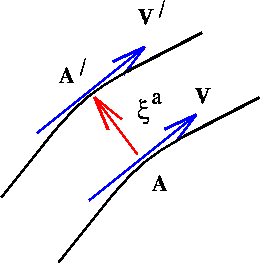We have shown that in a curved space [ for example on the surface of a balloon ] parallel lines when extended do not remain parallel. We will now formulate this mathematically in terms of the Riemann tensor.
Consider two geodesics with tangents ![]() and
and ![]() that begin
parallel and near each other at points A and A' [ see Figure 6.4 ].
that begin
parallel and near each other at points A and A' [ see Figure 6.4 ].

Figure 6.4: Geodesic deviation
Let the affine parameter on the geodesics be ![]() . We define a
connecting vector
. We define a
connecting vector ![]() which reaches from one geodesic to another,
connecting points at equal intervals in
which reaches from one geodesic to another,
connecting points at equal intervals in ![]() .
.
To simplify things, let's adopt a local inertial frame at A, in which
the coordinate ![]() points along the geodesics. Thus at A we have
points along the geodesics. Thus at A we have
![]() .
.
The geodesic equation at A is
![]()
since all the connection coefficients vanish at A. The connection does not vanish at A', so the equation of the geodesic at A' is
![]()
where again at A' we have arranged the coordinates so that
![]() . But, since A and A' are separated
by the connecting vector
. But, since A and A' are separated
by the connecting vector ![]() we have
we have
![]()
the right hand side being evaluated at A, so
![]()
Now ![]() so
so
![]()
This then gives us an expression telling us how the components of
![]() change. Let us now compute the full second covariant
derivative along
change. Let us now compute the full second covariant
derivative along ![]() ,
, ![]() :
:

In a local inertial frame this is

where everything is again evaluated at A. Using the result for
![]() we get
we get

since we have chosen ![]() .
.
The final expression is frame invariant, so we have in any basis
![]()
So geodesics in flat space maintain their separation; those in curved space don't. This is called the equation of geodesic deviation and it shows mathematically that the tidal forces of a gravitational field can be represented by the curvature of spacetime in which particles follow geodesics.